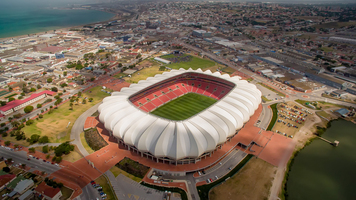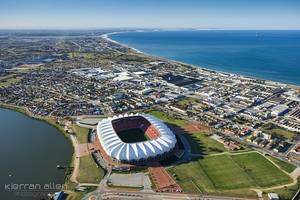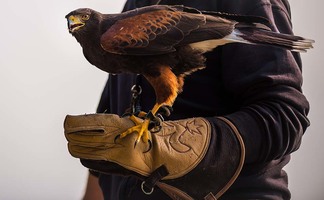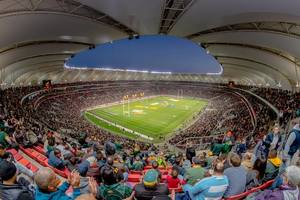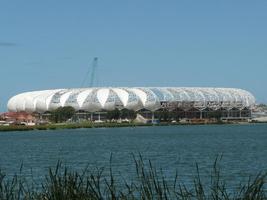URBAN RAPTOR PROJECT
The Nelson Mandela Bay Stadium is the only poison-free stadium in the world and has set a standard in efficient bird control. The Urban Raptor Project manages the new Port of Ngqura, Nelson Mandela Bay Logistics Park and the Nelson Mandela Bay Stadium using poison-free natural methods.
ABOUT THE PROJECT
The consulting engineers BKS and the stadium architect approached Urban Raptor Project in 2008.Stadium Architect Dominic Bonnesse was also involved at the Nelson Mandela Bay Logistics Park where the URP is responsible for a natural poison-free problem species control program.
After seeing and hearing about the success of the program there, he wanted it implemented in the stadium as well. Dominic had been on an international tour of stadiums and seen firsthand the damage caused by birds and also the financial cost of cleaning up behind them.
The URP commenced with initial stages of bird management in April 2009.Through controlling birds inside the stadium and keeping an eye outside, the stadium has to date no bird or rodent problems. Excellent waste management systems by the stadium management support this program.
EXOTIC BIRD CONTROL
The stadium is surrounded by a major concentration of feral pigeons. The structure is conducive to encouraging pigeons to roost and breed there. Every stadium in the world has major bird [mainly feral pigeon] problems. Feral pigeons need to be controlled or preferably eradicated totally because they are a health risk and compete with our indigenous bird species. This view is supported by all Nature Conservation authorities and ornithologists. • Feral pigeons are an exotic species and may be hunted at any time.
Birds are controlled inside the stadium by using trained falcons to disturb and hunt them. Birds attempting to roost at night inside the stadium are disturbed. Another problem species is the ever increasing urban crow populations which are also controlled inside the stadium. Crows interfere with the wiring systems on the speakers and create a major mess. The Nature Conservation Ordinance recognizes them as a problem species. At the end of February 2010 two raptor nest boxes were put up on the outside of the stadium to encourage Rock kestrels to take up residence. Local Rock Kestrels and African Peregrine falcons (from URP city nest boxes) come into the stadium to hunt.
RODENT CONTROL
Spotted Eagle Owl 2No poison is used for rodent control. All problem rodent control is done through mechanical means. By March 2010 a pair of captive bred Spotted Eagle owls were introduced to set up territory in the gardens of the stadium. To date there is no rodent problem in the stadium, mainly thanks to the natural predators such as kestrels and herons which can freely hunt any rodents without risk of secondary poisoning. The stadiums excellent waste management strategy also plays a key role here.
INSECT CONTROL
Two bat boxes have been prepared for the stadium. Bats are already making use of the stadium to hunt and are playing a role along with wagtails and kestrels in insect control on the pitch.
PROJECT WAGTAIL
Cape and African Pied Wagtails are present on the pitch. This is a first time recording for Pied wagtails in Port Elizabeth. These wagtails are also assist in controlling insect pests on the pitch. The wagtails are so well attuned to the falcons that whenever one flies through they just dive into the various drainage pipes and sit tight until danger passes.
For more information contact Arnold Slabbert at wildline@yebo.co.za
ENVIRONMENTAL MGMT.
ENVIRONMENTAL MANAGEMENT SYSTEMS
The environmental management system is a way of evaluating the environmental performance of the stadium against a set criteria. It analyses the current situation and usage of resources, and the connection between environmental considerations and economic limitations. The utilisation of energy, water and waste in a more efficient is the main areas of consideration.
The EMS reiterates the company’s commitment to environmental management and the adoption of environmental policy in order to achieve the levels and standards needed in the successful implementation. These commitments include the need to reduce waste, pollution water usage and energy. The current monitoring procedures help to monitor the achievement of these objectives and targets. The constant monitoring helps to identify re-occurring problems and can be used as means of establishing measures of prevention. The main objective is to increase the facilities and organisation environmental performance. The introduction of the EMS and hence the drive towards better performance has quantifiably reduced operational costs.
C-BUS SYSTEM
An intelligent lighting system which modifies lux levels (amount of light) and can programmed for efficient utilization. i.e. motion sensors and programmable time systems for switching off electrical equipment.
WATER WORKS
The water works system is a water purification plant. The Nelson Mandela Bay Stadium uses the water from the North End Lake for irrigation of the outer precinct however, this water known as grey water, is not fit for human consumption.
